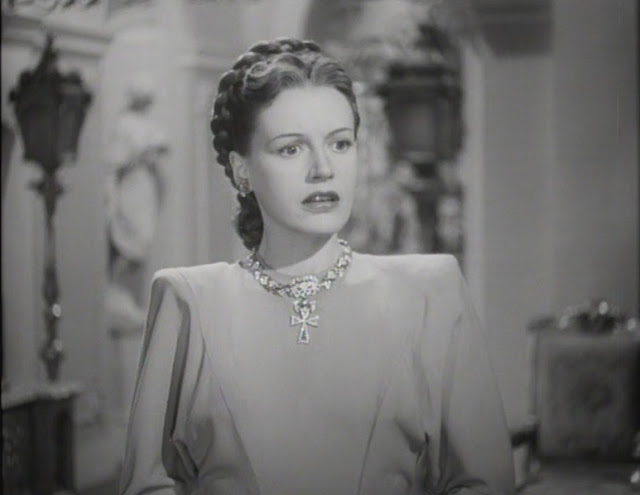Madonna of the Seven Moons (1945)
 |
| Phyllis Calvert |
I am recent convert to the films of Gainsborough Studios. As a youth I imagined they would be dull, romantic, costume dramas. If only I'd known the truth:
Instead they are deliciously over-the-top melodramas of a type that the film industry could never get away with these days.
And Madonna of the Seven Moons is maybe the cream-of-the-crop. Set in 1930s Italy, it tells the story of a young rape victim (played by Phyllis Calvert) who marries and has a daughter but, driven to madness by her early experiences, leads a double life. When gripped by madness, she loses all memory of her respectable life as the wife of a wealthy wine merchant and instead rushes into the arms of her gangster-lover, played by Stewart Granger.
 |
| Stewart Granger & Phyllis Calvert |
Calvert plays against type, being more familiar as the innocent victim, or the figure of stability as she played in Two Thousand Women or Indiscreet. As she later revealed to the author Matthew Sweet - author of Shepperton Babylon - she actually preferred to play a feisty character rather than a good-girl. And in Madonna of the Seven Moons she grabbed the opportunity and appears to relish the chance to go from convert school girl ...
 |
| Phyllis Calvert |
... to respectable housewife and mother ...
 |
| Phyllis Calvert |
... to woman on the verge of madness ...
 |
| Phyllis Calvert |
... to killer!
 |
| Phyllis Calvert |
The transformation is handled well, with Calvert changing her clothes at night before slipping out of the house dressed as a peasant woman. Even her hair colour appears to change to a darker hue courtesy of how she is lit. Her character change is reflected by a line delivered to her by Granger. Early in the film she is a quiet, pious, troubled woman, nervous about meeting her daughter after five years apart. But living with Granger in Florence she is set free. As he tells her: "I love it when you laugh - it's like ice and fire."
Considering the film was made in 1945, but set in late 1930s Italy, it is surprising that no mention of the fascist regime is made. But as an omission it is irrelevant. Instead we have plenty of other things to think about.
First of all we have the two leading ladies, Calvert and Patricia Roc, as mother and daughter:
 |
| Phyllis Calvert & Patricia Roc |
Whilst Calvert, 30 years old when the film was made, was the perfect age to be playing someone who had fallen pregnant as she left school and whose daughter has just finished school, Roc was a curious choice. Just months younger than Calvert, Roc was far too old to be playing a teenage girl. But she too relishes her role as the flirty, flighty teenager returning home from London to see her parents with her diplomat boyfriend in tow.
In light of the negligible age gap between them, it is comical to see Calvert playing the shocked mother seeing her daughter's fashion choice of shorts:
 |
| Patricia Roc |
 |
| Phyllis Calvert |
Whilst we are discussing the 'Gainsborough girls', one has to mention Jean Kent who plays Calvert's rival for the affections of Stewart Granger.
 |
| Phyllis Calvert & Jean Kent
|
However, in Madonna of the Seven Moons Kent keeps her clothes on and it is her familiar screen partner Patricia Roc who provides the glamour, dancing around her bedroom in her underwear:
Whilst the women steal the show, Granger does have the good fortune to wear an unusual and rather rare style of jacket. With pleats at the shoulder and waist, his light coloured double breasted jacket is a perfect contrast to the more traditionally styled suits of the more respectable characters:
So, Madonna of the Seven Moons: melodramatic, over-the-top, mysterious (we never discover whether Roc is the product of rape - although I suspect the audience is meant to assume it), and - above all else - great fun.
If you like wide-eyed stares ...
... murderous envy ...
... Italian wide-boys ...
... this is the film for you.
This original trade advertisement is currently available from Greg Edwards:










No comments:
Post a Comment